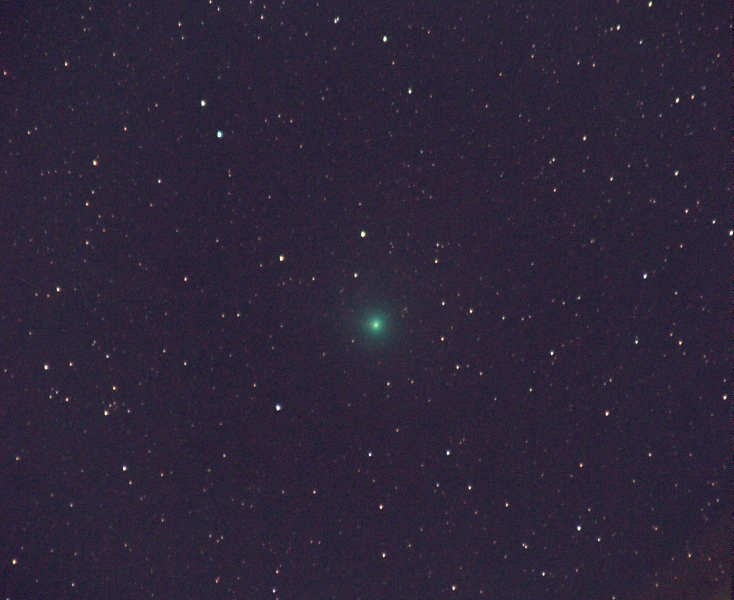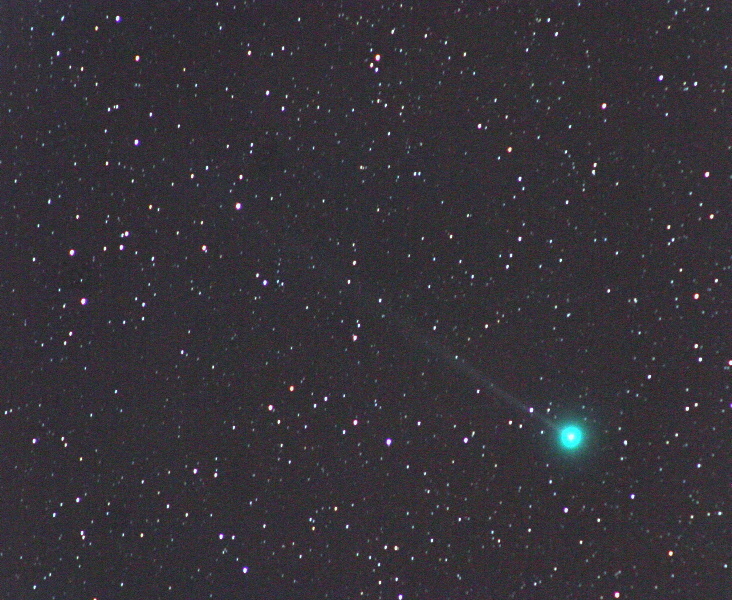Closest to Earth on 12 June 2008 at 0.21AU
Closest to Sun on 24 June 2008 at 0.85AU
Maximum magnitude 4.5 in June 2008
Orbital period = 74,519 years
Discovered by Andrea Boattini of the Mt Lemmon survey on November 20,
2007
This comet had good potential for becoming a relatively bright object during its
close approach to the Sun on June 24, 2008 at a distance of 0.85AU.
The apparition was highly favourable since a considerably close approach to the
Earth of 0.21AU occurred 2 weeks earlier on June 12.
Comet Boattini favoured observers in the southern hemisphere and was visible
during evening hours at its prime before moving into the morning sky.
A peak brightness of magnitude 5 was anticipated in June 2008 and it fared
slightly better than this.
The revised orbit indicated that the comet was a returning visitor, thus
prospects were high for a good showing.
At the start of April 2008, the magnitude 10 comet was situated in the
constellation of Corvus.

2008 April 6.
Comet C/2007 W1 meets the Ringtail galaxy NGC 4038/4039 in Corvus
It brightened 2 full magnitudes during April as it rapidly approached the
Earth and Sun.
It remained well situated for viewing during evening hours as it traversed the
constellations of Crater and Hydra.
During May 2008, the comet brightened further, from magnitude 8 to 6, as it
trekked westwards 1 degree per night through Hydra.
Moonlight interfered from May 13 to 23.
After the May full moon, the comet moved into Pyxis, travelling westwards at 2
degrees per day.

Comet C/2007 W1 on May 28.5
7 minute exposure, Canon 300d and 300mm zoom lens cropped. FOV 3 degrees wide.
Eta Pyx at top left.
Comet was visible with the unaided eye at magnitude 5.5.
The comet was at its brightest during June 2008, when it shone at magnitude 4.5
whilst traversing the constellations of Puppis, Canis Major and Lepus.

2008 June 2.42UT.
A stack of 2x2 minute exposures, Canon 300D digital camera.
200mm zoom
lens, cropped image. ISO 800. South is up.
Note NGC 2467 above the comet (star cluster with associated nebulosity)
and M93 to the lower left. Xi Pup is bright star at centre.
visual observation
2008 June 2.40 UT: m1=4.9, Dia.=20', DC=4...7x50mm Binoculars.
Comet appears as a large circular haze with no apparent tail visible.
Comet was faintly visible to the unaided
eye using averted vision.
Average sky transparency with limiting magnitude
about 5.5 to 6

2008 June 14.35UT.
A stack of 3x1 minute exposures, Canon 300D digital camera.
200mm zoom
lens, cropped image. ISO 800.
East is up. FOV 3 degree wide.
Moonlight interference. Note the faint ion tail pointing towards the left with Delta Lepii
just outside the field of view.
Comet was at low elevation and heading into the morning sky.
The comet was overtaking the Earth and reached solar conjunction on June 15.
Beyond this, the comet was observable in the morning sky before dawn, for the
remainder of its apparition.
The full moon on June 19 interfered with observing for the remainder of the
month.
By the start of July 2008, the comet, still shining at magnitude 5, was located
near the border of Eridanus and Taurus.
The ion tail was more pronounced after perihelion as seen in the photo taken
below.





